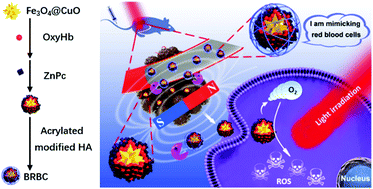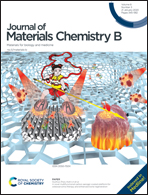Oxyhemoglobin nano-recruiter preparation and its application in biomimetic red blood cells to relieve tumor hypoxia and enhance photodynamic therapy activity†
Abstract
Photodynamic therapy (PDT) is strongly O2 dependent. Therefore, its therapeutic effects are seriously hindered in hypoxic tumors. Red blood cells are responsible for delivering O2 in the blood. In this manuscript, biomimetic red blood cells (BRBCs) were exploited using a layer-by-layer assembly method, using Fe3O4@CuO, oxyhemoglobin (OxyHb), a photosensitizer and a photo-cross linked acrylate modified hyaluronic acid (HA) gel shell. The Fe3O4@CuO core has very high OxyHb loading efficiency (the adsorption capacity of Fe3O4@CuO for OxyHb is derived to be 0.99 mg mg−1) to ensure a sufficient O2 supply. OxyHb was protected well by the HA shell in order to avoid O2 release during the delivery process in blood before arrival at the tumor tissue. The HA shell protection can be eliminated in position at the tumor to trigger O2 release through hyaluronidase (HAase) triggered HA degradation. Furthermore, Fe3O4 in the nanosystem can provide magnetic field assisted tumor targeting and magnetic resonance imaging of the tumor. Therefore, this work presents a highly efficient all-in-one biomimetic nanomedicine approach to overcome hypoxia and achieve tumor targeting theranostics.



 Please wait while we load your content...
Please wait while we load your content...